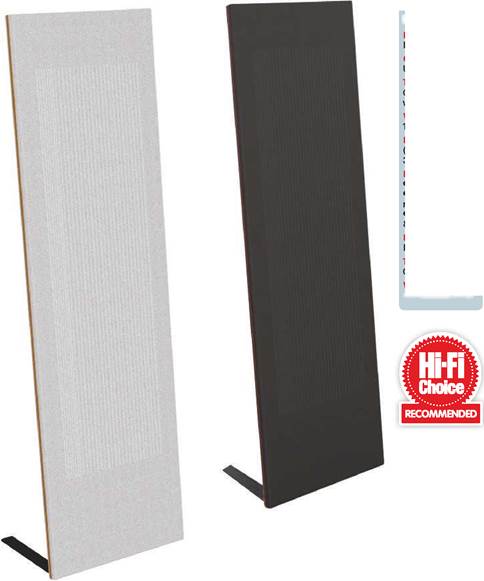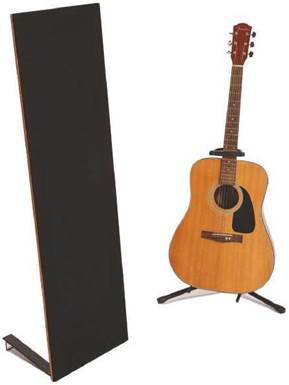Magnepan LRS Review – Maggie May
Chris Ward goes flat out to discover if Magnepan’s entry-level panel offering does enough to tempt a new era of fans. Read our Magnepan LRS Review.

At some point, many of us may have wondered if it’s possible to squeeze some ‘Maggies’ into our listening rooms. Maybe you’ve heard them at a hi-fi show, and were blown away by the speed, purity and coherence. Then there is that awful dawning realisation that you don’t actually live in a palatial mansion and would have to buy a new house first. Well, Magnepan has clearly listened and may just have answered your prayers.
The LRS (Little Ribbon System) stands just 1.2m tall and can be yours for the relatively modest sum of £.
At first glance the ‘Maggie’ is simply a 3cm-thick black rectangle, but shining a torch through the grille reveals a number of thin vertical strips, thinner ones acting as a tweeter and thicker ones performing low-frequency duties in this two-way design. Helpfully the speaker also comes with extra resistors that you can use to attenuate the tweeter
DETAILS
PRODUCT Magnepan LRS
ORIGIN USA
TYPE Quasi-ribbon, twoway loudspeaker
WEIGHT 18kg
DIMENSIONS (WxHxD) 370 x 1,220 x 25mm
FEATURES
• 2-way quasi-ribbon
• Frequency response: 50- 20kHz
• Quoted sensitivity: 86dB/1W/1m (4ohm)
DISTRIBUTOR Decent Audio
TELEPHONE 05602 054669
WEBSITE decentaudio.co.uk
energy if you have a particularly bright room. To be clear, this is not an electrostatic speaker and so doesn’t require mains power. Instead it’s described as a ‘quasi-ribbon’ where a metal foil is attached to an ultra-thin, tensioned Mylar film within a permanent magnetic field.
Proper setup is vital. Being a dipole speaker the LRS creates as much sound behind it as in front, so place it too close to a rear wall and reflected sounds can smear what you’ll hear. Equally, bass response can vary with small movements, as bass behind the speaker is naturally out of phase – nullifying some of its deeper register. While the panels may look identical, they come as handed pairs with tweeter ribbons intended to be on the outside edge giving treble energy a slightly longer route to the ears. Some prefer the speakers reversed with tweeters on the inside, but I concur with the designers. Helpfully Magnepan puts a ‘1’ and ‘2’ after the serial numbers of each cabinet so you needn’t get confused. While far
It remains totally coherent across a surprisingly wide frequency range
smaller than some of its full-grown siblings, it still needs some air around it. I find the optimum position is about 0.8m away from the back wall with some gentle toe-in. The feet also have ‘flippers’ that can be folded down to tilt the speaker forward a little for better alignment.
While the LRS represents superb value for money, it does have rather expensive taste in amplification. Use a cheap, modestly powered integrated and you’ll get lacklustre results. This is because the claimed 86dB at 4ohm means it represents a significant load. From experience, it excels on a diet of high-current delivery rather than pure watts, so factor in muscly amplification to get the best outcome. I’m blessed with the Norma Audio Revo IPA-140 integrated from HFC 464. I connect up a Shanling CD-T100 CD player via Chord Company Epic interconnects and use Black Rhodium Foxtrot (HFC 412) speaker cable. Magnepan recommends bare wire connections, but the grub screw connectors grip banana plugs securely enough.
Sound quality
Playing a live rendition of Neil Young’s Old Man on CD the LRS instantly paints a tall, deep soundscape that catches me off guard. This may be a smaller panel, but the image it depicts will dwarf almost any other speaker at the same price. The panel is pretty directional, but off-axis listening is surprisingly strong. One is instantly struck by the coherence of Young’s vocal range. Where traditional dome tweeter and cone woofer designs have to be carefully blended to achieve a seamless presentation, the LRS just dives straight in with a vast, compelling picture that just makes complete sense. This seemingly unfiltered take on reproduction is addictive. I hear new, subtle nuances in vocals and tiny reverberations in the acoustic space that place me straight in the Massey Hall in 1971. Treble detail is hugely revealing but never harsh and rather than potentially stripping this plaintive song bare, I just get more and more emotional communication. Stunning!
Swapping to some electronica with Kaytranada’s You’re The One, I’m partially expecting the LRS to reveal a weak suit around bass extension, but I’m surprised again. On paper it only claims 50Hz, but that isn’t my perception. The bass is so fast, agile and textured that your brain seems to subliminally fill in the very lowest detail. Kick drums don’t pummel your solar plexus, but their attack is so realistic that you still get the impact. The speed of the panel is unsurpassed and the depiction of razor-edged percussion and keyboard makes the track sound completely fresh and new, while the vocals have a new level of intimacy and emotion. One might reasonably expect that being so explicit could dry the track out or reduce the boogie factor, but the opposite is in fact the case.
INSIGHT

1) Flip-out feet for better alignment
2) Bi-wireable binding posts

The LRS is a Magnepan that you can finally fit into your Home Playing Arvo Part’s Magnificat sung by the Tallis scholars is a treat. The LRS showcases the full mastery of close harmony singing with tiny dissonances and resolutions revealed in ways I’ve not heard before. This portrayal is luxurious, with the tone, timbre, intonation and expression of each part feeling entirely full and complete, yet joined as an ensemble to become a sumptuous whole. The clarity and transparency highlights individual talent and collective mastery. Furthermore the vast acoustic of the recording space is elevated to the farthest extremes of my listening room in a way that no box speaker can touch at this price point. The LRS paints sublime detail on a different scale.
Conclusion
I urge you to check out this bargain offering. If you’re an ardent metal head, it’s possibly not for you. But if you like what you hear, chances are you’ll love the LRS and may never be able to listen to traditional drivers in a box again. This is a starter speaker that you may never need to upgrade, just improve the amplification and sources. It’s really that good.
Lightning fast and easily able to communicate the fastest musical transients, it remains totally coherent across a surprisingly wide frequency range. Its rendition of vocals and acoustic instruments may startle you. Bass won’t shake your room, but it does dig deeper than you’d expect and depict texture that’s utterly absent from other designs. If you have enough space for the LRS to breathe and the amplification it deserves, you may soon find yourself a convert. Highly recommended
OUR VERDICT
HOW IT COMPARES
KEF’s LS50 (HFC 384) has superb imaging and tonal coherence, but can still sound boxy compared with the LRS. Its bass extension has a little more punch and it’s a far easier load that will suit more amps and easy placement, but you’ll need to budget for quality stands and its presentation sounds rather flat when compared with the Magnepan LRS.






